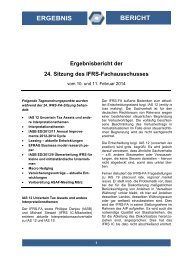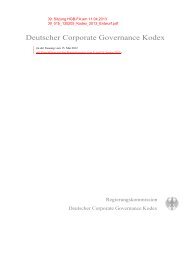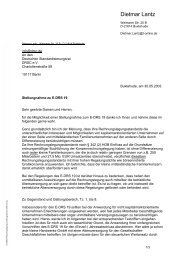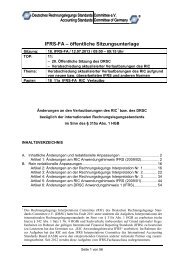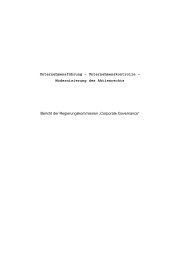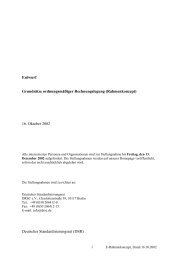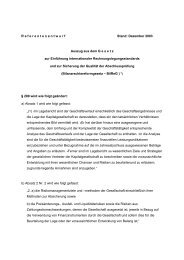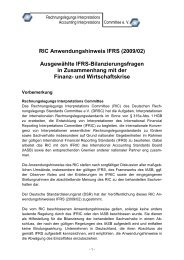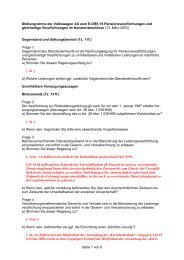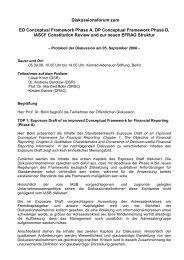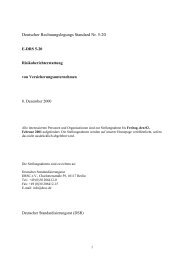Classification and Measurement: Limited Amendments to IFRS 9
Classification and Measurement: Limited Amendments to IFRS 9
Classification and Measurement: Limited Amendments to IFRS 9
You also want an ePaper? Increase the reach of your titles
YUMPU automatically turns print PDFs into web optimized ePapers that Google loves.
CLASSIFICATION AND MEASUREMENT: LIMITED AMENDMENTS TO <strong>IFRS</strong> 9 (PROPOSED AMENDMENTS TO <strong>IFRS</strong> 9 (2010))<br />
Appendix B<br />
Application guidance<br />
This appendix is an integral part of the <strong>IFRS</strong>.<br />
Paragraph B3.1.6 is amended. New text is underlined.<br />
Recognition <strong>and</strong> derecognition (chapter 3)<br />
Regular way purchase or sale of financial assets<br />
...<br />
B3.1.6 The settlement date is the date that an asset is delivered <strong>to</strong> or by an entity.<br />
Settlement date accounting refers <strong>to</strong> (a) the recognition of an asset on the day it<br />
is received by the entity, <strong>and</strong> (b) the derecognition of an asset <strong>and</strong> recognition of<br />
any gain or loss on disposal on the day that it is delivered by the entity. When<br />
settlement date accounting is applied, an entity accounts for any change in the<br />
fair value of the asset <strong>to</strong> be received during the period between the trade date<br />
<strong>and</strong> the settlement date in the same way as it accounts for the acquired asset. In<br />
other words, the change in value is not recognised for assets measured at<br />
amortised cost; it is recognised in profit or loss for assets classified as financial<br />
assets measured at fair value through profit or loss; <strong>and</strong> it is recognised in other<br />
comprehensive income for assets classified as financial assets measured at fair<br />
value through other comprehensive income in accordance with paragraph<br />
4.1.2A <strong>and</strong> investments in equity instruments accounted for in accordance with<br />
paragraph 5.7.5.<br />
Paragraphs B4.1.1 <strong>and</strong> B4.1.3–B4.1.4 are amended. Paragraphs B4.1.2A–B4.1.2B are<br />
added. Paragraph B4.1.2 is included for reference only <strong>and</strong> is not proposed for change.<br />
New text is underlined <strong>and</strong> deleted text is struck through.<br />
<strong>Classification</strong> (chapter 4)<br />
<strong>Classification</strong> of financial assets (section 4.1)<br />
The entity’s business model for managing financial assets<br />
B4.1.1 Paragraph 4.1.1(a) requires an entity (unless paragraph 4.1.5 applies) <strong>to</strong> classify<br />
financial assets as subsequently measured at amortised cost or fair value on the<br />
basis of the entity’s business model for managing the financial assets. An entity<br />
assesses whether its financial assets meet this the condition in paragraph 4.1.2(a)<br />
or in paragraph 4.1.2A(a) on the basis of the objective of the business model as<br />
determined by the entity’s key management personnel (as defined in IAS 24).<br />
B4.1.2 The entity’s business model does not depend on management’s intentions for an<br />
individual instrument. Accordingly, this condition is not an<br />
instrument-by-instrument approach <strong>to</strong> classification <strong>and</strong> should be determined<br />
17<br />
� <strong>IFRS</strong> Foundation



